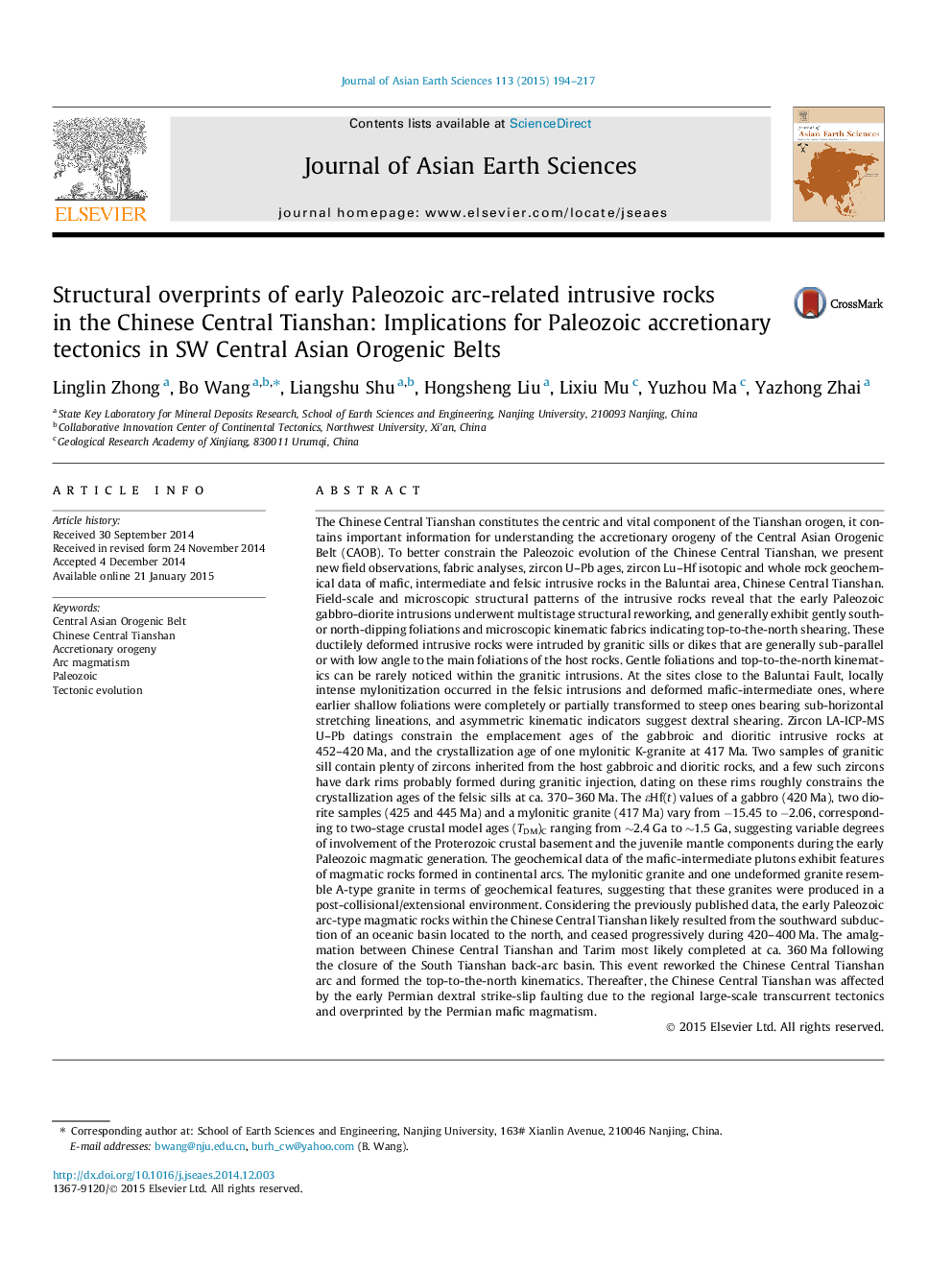| کد مقاله | کد نشریه | سال انتشار | مقاله انگلیسی | نسخه تمام متن |
|---|---|---|---|---|
| 4730223 | 1356743 | 2015 | 24 صفحه PDF | دانلود رایگان |

• Arc-related magmatism in Central Tianshan occurred in 450–420 Ma and ceased at 417–400 Ma.
• Top-to-the-north ductile shearing deformed the early Paleozoic arc-type intrusions.
• Mid-late Paleozoic intrusions were free from regional N–S compressive ductile deformation.
• Early Carboniferous amalgamation of the Central Tianshan and Tarim is proposed.
• Paleozoic intrusive rocks were locally mylonitized due to Permian transcurrent tectonics.
The Chinese Central Tianshan constitutes the centric and vital component of the Tianshan orogen, it contains important information for understanding the accretionary orogeny of the Central Asian Orogenic Belt (CAOB). To better constrain the Paleozoic evolution of the Chinese Central Tianshan, we present new field observations, fabric analyses, zircon U–Pb ages, zircon Lu–Hf isotopic and whole rock geochemical data of mafic, intermediate and felsic intrusive rocks in the Baluntai area, Chinese Central Tianshan. Field-scale and microscopic structural patterns of the intrusive rocks reveal that the early Paleozoic gabbro-diorite intrusions underwent multistage structural reworking, and generally exhibit gently south- or north-dipping foliations and microscopic kinematic fabrics indicating top-to-the-north shearing. These ductilely deformed intrusive rocks were intruded by granitic sills or dikes that are generally sub-parallel or with low angle to the main foliations of the host rocks. Gentle foliations and top-to-the-north kinematics can be rarely noticed within the granitic intrusions. At the sites close to the Baluntai Fault, locally intense mylonitization occurred in the felsic intrusions and deformed mafic-intermediate ones, where earlier shallow foliations were completely or partially transformed to steep ones bearing sub-horizontal stretching lineations, and asymmetric kinematic indicators suggest dextral shearing. Zircon LA-ICP-MS U–Pb datings constrain the emplacement ages of the gabbroic and dioritic intrusive rocks at 452–420 Ma, and the crystallization age of one mylonitic K-granite at 417 Ma. Two samples of granitic sill contain plenty of zircons inherited from the host gabbroic and dioritic rocks, and a few such zircons have dark rims probably formed during granitic injection, dating on these rims roughly constrains the crystallization ages of the felsic sills at ca. 370–360 Ma. The εHf(t) values of a gabbro (420 Ma), two diorite samples (425 and 445 Ma) and a mylonitic granite (417 Ma) vary from −15.45 to −2.06, corresponding to two-stage crustal model ages (TDM)C ranging from ∼2.4 Ga to ∼1.5 Ga, suggesting variable degrees of involvement of the Proterozoic crustal basement and the juvenile mantle components during the early Paleozoic magmatic generation. The geochemical data of the mafic-intermediate plutons exhibit features of magmatic rocks formed in continental arcs. The mylonitic granite and one undeformed granite resemble A-type granite in terms of geochemical features, suggesting that these granites were produced in a post-collisional/extensional environment. Considering the previously published data, the early Paleozoic arc-type magmatic rocks within the Chinese Central Tianshan likely resulted from the southward subduction of an oceanic basin located to the north, and ceased progressively during 420–400 Ma. The amalgmation between Chinese Central Tianshan and Tarim most likely completed at ca. 360 Ma following the closure of the South Tianshan back-arc basin. This event reworked the Chinese Central Tianshan arc and formed the top-to-the-north kinematics. Thereafter, the Chinese Central Tianshan was affected by the early Permian dextral strike-slip faulting due to the regional large-scale transcurrent tectonics and overprinted by the Permian mafic magmatism.
Journal: Journal of Asian Earth Sciences - Volume 113, Part 1, 1 December 2015, Pages 194–217